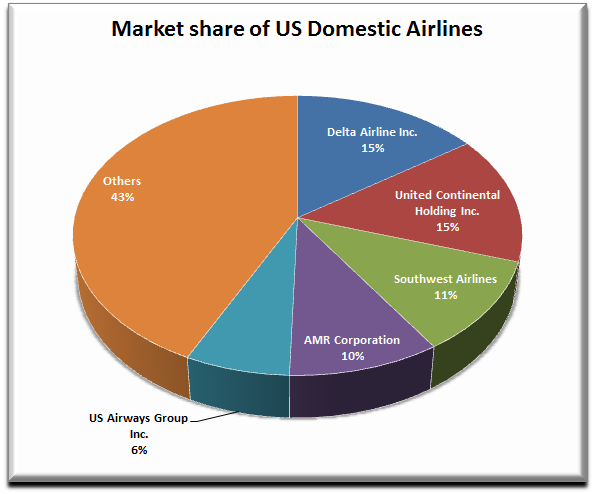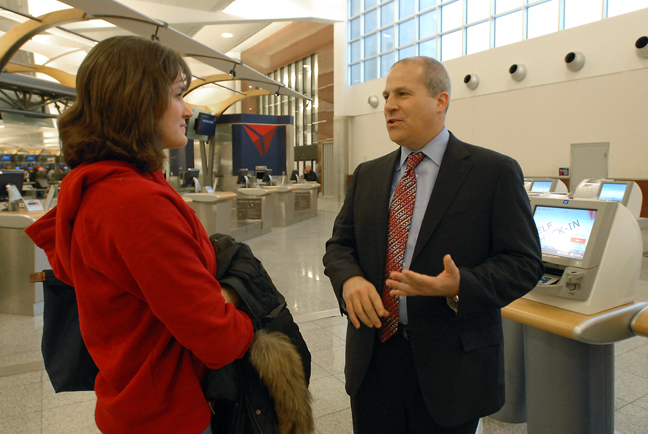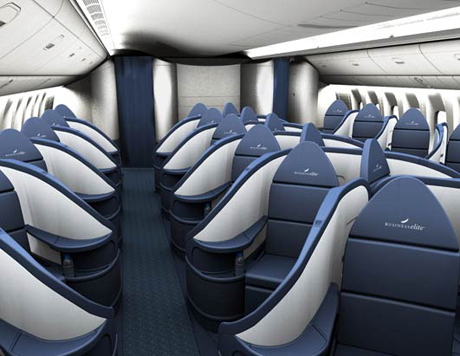Delta Airlines
Friday, 24 May 2013
Overview Of The Airline Industry
Embracing
new technology was a crucial strategy by every airline industry in America.
Digital operation helps companies to decentralize its services and also reduce
the cost of labor. By 2004, almost all airline industries had advanced in to a
digital company. Despite Southwest’s development of a ticketless travel
personal computer reservation, Delta changed the internal and external
environment with a significant commitment and investment in technology and
innovation to enhance customer satisfaction. Delta
management team focused on technological innovation and creativity to ensure
quality service provision. Economists argue that large amount of online and
media advertising has increased competition among the airline companies. This
has enabled companies to persuade its customers hence expanding its markets.
Despite this, the practice of online management by Delta always reflects the
culture of a society. Where technology is likely to lead to increased
performance and motivation, then management of Delta encouraged culture through
competition, through contests or by publicizing results and performance.
Over
the past decade, American airline industry has faced significant transitions in
environment of operation, including economic recession, technological changes
and high volatile fuel prices. As a result of such changes, the companies are
facing a considerable financial challenge that has resulted to bankruptcy.
Airline have responded to these challenges by introduction of online
transaction with customers hence introducing new affordable passengers and
reduced number of schedules. Although the operation costs were significantly
increasing, airline companies developed financial strategies aimed at
stabilizing inflation status in the industry. The emergence of harsh economic
recession has reduced the capacity of passengers using the industry. The demand
of air travel has been regularly decreasing as consumers are overcome by the
expensive travelling cost.
From
2002, America’s airline industry started experiencing over-capacity in
passenger and cargo. This resulted to expansion of e-business and purchase of
technologically updated aircrafts. Delta advanced in to a digital a company in
2000 and also purchased 500 seat Boeing 787. This revolutions transformed the
industry in to a competitive environment with the aim of satisfying the growing
capacity. Airlines developed building blocks of high performance by focusing on
market strategies, distinctive capabilities and performance autonomy. Strengthening
market share was another ambition for companies to penetrate the superior
markets. Delta strive to achieve a dominant domestic market position and
establishment of a strong local operational presence. Despite the growing
financial strains in the industry, the companies are maximizing the available
resources to expand in to new markets. This will also transform the companies
hence adopting to restore profitability.
The airline industry is also the advanced technology to develop organizational capacity. Attaining strong and reliable organizational capacity is another organizational goal that Delta airlines focused on. The organization structure was strategized to ensure provision of the highest quality travelling services to customers. Most airline industries developed quality management techniques to ensure that each secured customers at their capacities. To achieve this, companies created friendly environment for the employers through increase in basic pays and putting them in to reward programs. Straszheim, M. R. (1969) argues that organizational capacity can result to development of a clearly defined strategy gives strategic intent and drive to an organization. After companies advanced technologically, airline industry was characterized by strategies which are equally important to the business as well as the community in which the industrial operation consequently affects. This helped companies in identification of the company’s long-term goals, implementation of specific course of action and using available, necessary resources to realize the goals.
Competition
Airline
sector in the United States economy is characterized by strong competition, and
competitors are taking their operations in a frequently changing market
atmosphere. The airline industry was named the most competitive industry in the
United States since 1990s. Although Delta had the strongest competitive advantage,
the changing economic and technologic forces did not favor any individual
company (Hanlon, 1996).
Southwest and American airlines are the biggest threat
in the industry. Although the industry is generally characterized by high fixed
cost and low operating profits, Delta established significant strategies to
enable it maintain its future customers at the lowest cost. Southwest developed
its e-business model few years after delta advanced in to a digital company. This
saw the operating profits of Delta decrease by more than 10% in the subsequent
years. Despite being successful in implementation of bookings, Brook and Dyer
(1996) argue that Southwest gained much loyalty from the customers and other
stakeholders in the industry than any other Airline (Hanlon, 1996).Competition
in the industry varies internationally, nationally, regionally and the cargo
size carried. Delta has been forming alliances with the aim of strengthening
its competitive advantage through service diversification. Alliances with
Virgin Atlanta and northwest airlines was one of the biggest achievement of
Delta in securing a reliable competitive position in United States airline
industry. These mergers and alliances created a global carrier that can compete
both in domestic and international markets (Hanlon, 1996). This was a big blow
to its competitors like Southwest which never formed international alliance
with major airlines. Alliance is an effective way to compensate higher fuel
prices. By 2008, Delta had the most stable record fuel prices in the industry.
Efficiency, ability to fund operating expenses and long-term investments, and
increase in international operations has ensured a secure competitive advantage
in the industry.
Development of e-business
increased online competition for customers through web rivalry. Airline
companies developed cheap and accessible website for customer to timely
purchase travelling tickets and get information on changing market trends. In
addition to reliable sites, Delta established the fastest wireless network
within the airport to enhance easier communication between employees in the
plane and the technical team at the airport. This facilitated safety services
and sustainability measures against accidents. (Hanlon, J. P. (1996). Global airlines: competition
in a transnational industry. Oxford)
Customer Feedback
Development of e-business led to perfect and timely communication between the company and its customers. This resulted to a stable and reliable customer relationship in the airline. The new electronic model was able to specify the type of relationship the company needs to establish with each customer. The website of the company provided an efficient communication channel for the passengers to forward complains and views concerning the services provided. The company transformed their model to radically different one, where customers personally have a direct communication with the customer service providers online. Delta used the analytic tools to provide qualitative data on site passenger behavior. Although it does not give a direct feedback, it is a popular way of getting direct information from customers. Customers could provide feedback, as verbal and nonverbal reactions to the communicated message. The management pay close attention to this feedback, as it is the only thing that can give confidence that the passengers has understood the message. (Rogers, 2004).The management at Delta established annual general meeting with its customers to ensure a complete communication. The online customer services could evaluate questions, suggestions and complains from the customers, which were then addressed during the meetings. Although not many passengers appeared for such meetings, the issues could be addressed hence improving company’s performance. Delta also developed online communication networks between the employees and customers. The strategy was used to improve the quality of services provided. To achieve this, Delta established wireless enabled network within the airports and inside the planes. Passengers enjoyed free internet services which enhanced customer-customer communication. The passengers could exchange ideas concerning the services provided and develop a common feedback to the customer service. (Rogers, 2004)Apart from online interaction, the company communicated with its customers through the media. Although media was one way channel, it was the most effective, cost effective and timely technique to globally communicate to customers. The company also used campaign trails to reach all its customers, especially in the outcasts. This included event organized to celebrate achieved missions and goals and also promotional events aimed at rewarding loyal customers. (Peppers, D., & Rogers, M. (2004). Managing customer relationships a strategic framework. Hoboken).
Income Sources
Delta’s
financial condition is very appealing to its stakeholders. According to
company’s annual reports Delta has been operating under increasing revenues
since it developed the e-business model (Morrell, 2002). The major source of
income for Delta airlines is the sale of travelling tickets. This covers about
70% of the total revenues generated. In 2012, the company reported revenue of
about $36.6 billion which was about 5% increase from 2011. This was brought by increase
in the number of passengers in that financial year. The company also earns
income from sell of shares. Delta CEO Anderson Richard argue that the company’s
return to profitability started in 2010 when the company made $1.71 per share
leading to income of about $1.5 billion in 2011.Disposal
and leasing of assets is another source of income to Delta. According to the
management, lending out brought more revenues than disposal of assets.
Priceline was the most convenient partner in disposal of excess and unused
furniture (Morrell, 2002). In 2011 Delta earned about $2 billion from disposal
and leasing of assets. This revenue was used in development of both employees
and customer reward program. Delta makes revenue from non-tickets including
in-flight food, baggage charges and travel insurance. The company made about
$22 billion from these in 2011. These ancillary revenue are used to provide a
boost for runway fuel bills. The company also made revenues from
telecommunication services. Economists argue that aviation industry are
indirectly charging customers for internet related services. From the SWOT
analysis carried in 2012, Delta developed cost saving strategy to save on the
generated revenues. Fuel hedging program and operational improvement were developed
through effective flight scheduling, older less fuel efficient fleet, improving
maintenance process and maximizing crew resources.
(Morrell, P. S. (2002). Airline
finance. Aldershot, Hants, England, Ashgate.)Impact
of digital sourceDigital
source has brought positive development strategies to Delta hence currently
enjoying superiority in the airline industry. In 1994, the company became the
first airline in the industry to technologically advance its operations hence
meeting customer satisfaction, Delta airlines grouped its customers according
to needs, behaviors and attributes. Internet has become a distribution channel
for sale of tickets. Over 1.5 billion people globally use the internet hence
Delta is able to minimize communication cost with its companies (Teneja, 2002).Digital
source has contributed to the profitability of Delta. The internet works as
management and distribution channel tool. Digital business have the advantage
of management cost reduction hence becoming a key element in improving
operating profitability. Digital source has also enabled Delta to work
correctly with the current market situation. The company’s website ensures that
all the markets in the industry are accessed (Teneja, 2002).
The
fast search engines in the company’s website have enhanced easier access to the
site by passengers. Digital business has strengthen relationship between the
company and customers. This ensures easier communication and timely attendance
to the customers’ preferences. A strong Customer relationship improves the
competitive capacity of the company. Since the Delta advanced as digital
company, its competitive advantage has been gradually strengthening. E-business
ensured awareness of who to be addressed and the requirement of the passengers.
This can help delta to utilize the available resources to ensure achieving the
management target towards customer satisfaction. Aside from the opportunity to
visit a wide variety of on-line shops, e-business allows customers to check
complete information about a certain new service. In addition to that, there
are no sales persons pressuring the customer into buying a product. (Taneja, N.
K. (2002). Driving airline business
strategies through emerging technology).
Product Development
Delta’s
product management is well defined in its annual reports. Most airline
companies in United States demonstrate strategies in their operations which is directed
to support their target costing process. Delta airlines have an effective
management structure which respond to customer demands through a streamlined
product development process. (Meryer, 1981). This was aimed at strengthening
the competitive advantage of the Airline. Delta had introduced quality
management techniques through their web. Online team with special knowledge on
quality improvement techniques was established to ensure product development
hence satisfying passenger needs. This
team is aimed at developing new technique of production to secure the markets. (Oster,
1981).
Delta
airline have done international alliance with other airlines and airline
related industries like hotels to ensure effective product development. In
2012, Delta announced alliance with Virgin Atlantic. Delta acquired 49% of
Virgin’s shareholding. This helped Delta to utilise the excess production
capacity and maximise its available resources. The alliance led to easy access
to cost friendly travelling tickets to passengers. Since Delta advanced to a
digital company, it has also formed alliances with international hotels. This
strategy was aimed at providing meals and beverages within the airports and
also inside the planes. Passengers travelling in odd hours can also access
cheap accommodation (Meyer, 1981).
Delta airline established a
quality management team to ensure quality services to the passengers. The team
was aimed at product development as to the preference of customers. To achieve
this, Delta introduced training programs for both executive and general
employees to enhance new consumer favouring techniques in service provision
(Meryer, 1989). The company also used performance appraisal system to ensure
employees deliver to their maximum capacity. Although the Delta linked employee
performance appraisal with employee reward program, the employees were
motivated more on satisfying the customers’ preferences. Economists argue that,
the product development strategy has been the best ever in the airline
industry. The sustainability of Delta was as a result of regular development of
new products and maximisation of its e-business model. Many customers need to
be satisfied by new products and services.
(Meyer, J. R., & Oster, C. V. (1981). Airline deregulation: the early experience.
Boston)
Subscribe to:
Posts (Atom)



